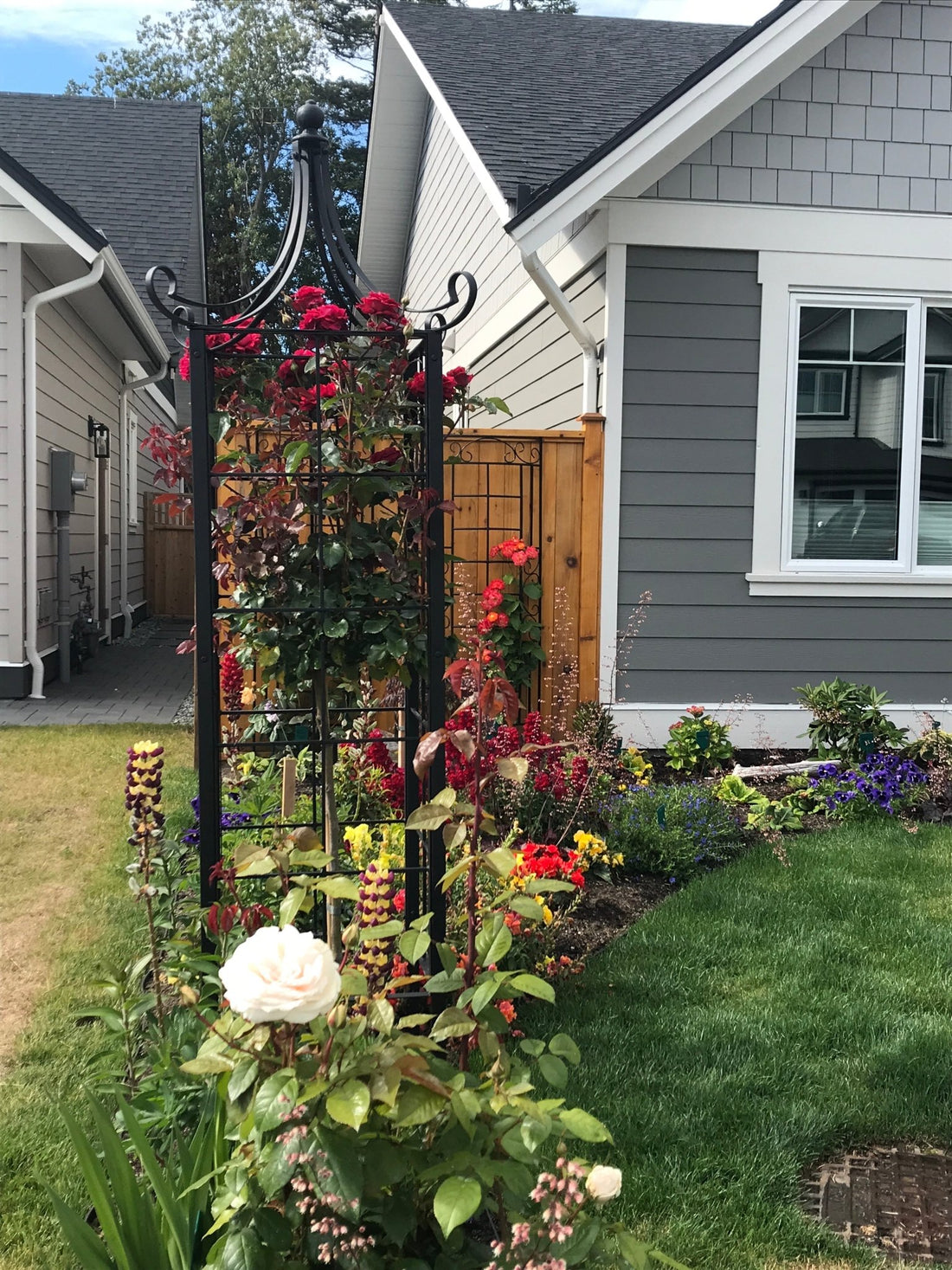A garden obelisk serves both a functional and ornamental purpose in a garden or outdoor space. Garden obelisks offer vertical support for climbing plants, allowing various options for what can be grown on them. Remember to consider the height and the sturdiness of the obelisk, as some plants can get quite heavy as they grow.
What is the Purpose of a Garden Obelisk
Support for Climbing Plants
Primarily, an obelisk provides structural support for climbing plants such as vines, roses, or certain vegetables like beans or peas. These plants naturally tend to climb, and the obelisk offers a vertical structure for them to grow on, aiding in their upward growth.
Aesthetic Enhancement
Beyond its functional use, an obelisk adds an elegant and decorative element to the garden. Its tall, often pyramid-like structure, crafted from various materials such as metal, wood, or even stone, serves as a focal point, adding visual interest and architectural appeal to the garden.
Space Optimization
Obelisks can also help maximize garden space by allowing vertical gardening. This is particularly useful in smaller gardens or areas where space is limited. Growing vertically can increase plant yield and variety without spreading out over a large area.
Defining Spaces
Placing obelisks strategically can define or segment different areas of the garden, creating visual boundaries or pathways within the outdoor space. A garden obelisk is a versatile garden structure that combines both utility and aesthetics, providing support for climbing plants while enhancing the overall visual appeal of the garden.
What Can Be Grown on a Garden Obelisk?
Climbing Roses obviously love to climb and they look stunning on obelisks, adding color and fragrance to your garden.
Clematis known for its beautiful, large flowers, clematis vines thrive when provided something to climb.
Morning Glory a fast-growing vine with vibrant, funnel-shaped flowers that thrive on trellises and obelisks.
Sweet Peas these delicate, sweet-smelling flowers are perfect for obelisks and create a beautiful display.
Vining Vegetables plants like beans, peas, and cucumbers can climb up obelisks, utilizing vertical space and making harvesting easier.
Do You Plant on the Inside or Outside of a Garden Obelisk?
The decision to plant on the inside or outside of a garden obelisk depends on the specific plant's growing habit and the design of the obelisk. Here are some considerations:
Inside Planting
If the obelisk is a solid structure with a wide base and narrower top, planting on the inside allows the vines or plants to naturally wrap around the structure. This often provides more stability and support for climbing plants as they grow upward.
Outside Planting
Some obelisks have outward-facing horizontal bars or braces, making it easier to plant on the outside. This allows vines or plants to grow along the bars, showcasing them more visibly and creating a decorative effect.
Both methods can work well. Choose the planting method based on the design of the obelisk and the growth habit of the plant you intend to grow. Some plants might naturally seek support on the inside, while others might thrive better when planted on the outside.
What Is Another Name for a Garden Obelisk?
Garden obelisks are sometimes referred to as Tuteurs, garden towers or plant towers. Historically, obelisks have held significant symbolism, often representing power, stability, and strength. In gardens, they serve not only as decorative elements but also as structures to support climbing plants, adding vertical interest and elegance to outdoor spaces. Their upward-reaching shape symbolizes growth, aspiration, and balance within the garden landscape.
"Tuteur" and "trellis" are related to garden structures but are not typically synonymous with "obelisk." While all three are used for supporting climbing plants, they have distinct differences:
Obelisk: Usually a tall, four-sided structure with a pyramid-shaped top. Obelisks rise vertically and are used to support climbing plants while also adding architectural interest to the garden landscape.
Tuteur: Similar to obelisks, tuteurs are also used to support climbing plants. However, they often have a conical or circular shape, sometimes resembling a teepee or pyramid but without the distinct squared sides seen in backyard obelisks.
Trellis: Trellises are more commonly flat or latticed panels or structures that plants can climb or be trained upon. They can be either freestanding or attached to a wall or fence. Unlike obelisks, trellises usually don't have a distinct vertical shape but rather a pattern of crisscrossed or parallel bars.
While these terms may overlap in function—supporting climbing plants—they each have unique shapes and designs, with the obelisk being more pyramid-like, the tuteur often cone-shaped, and the trellis being a flat or latticed structure.

